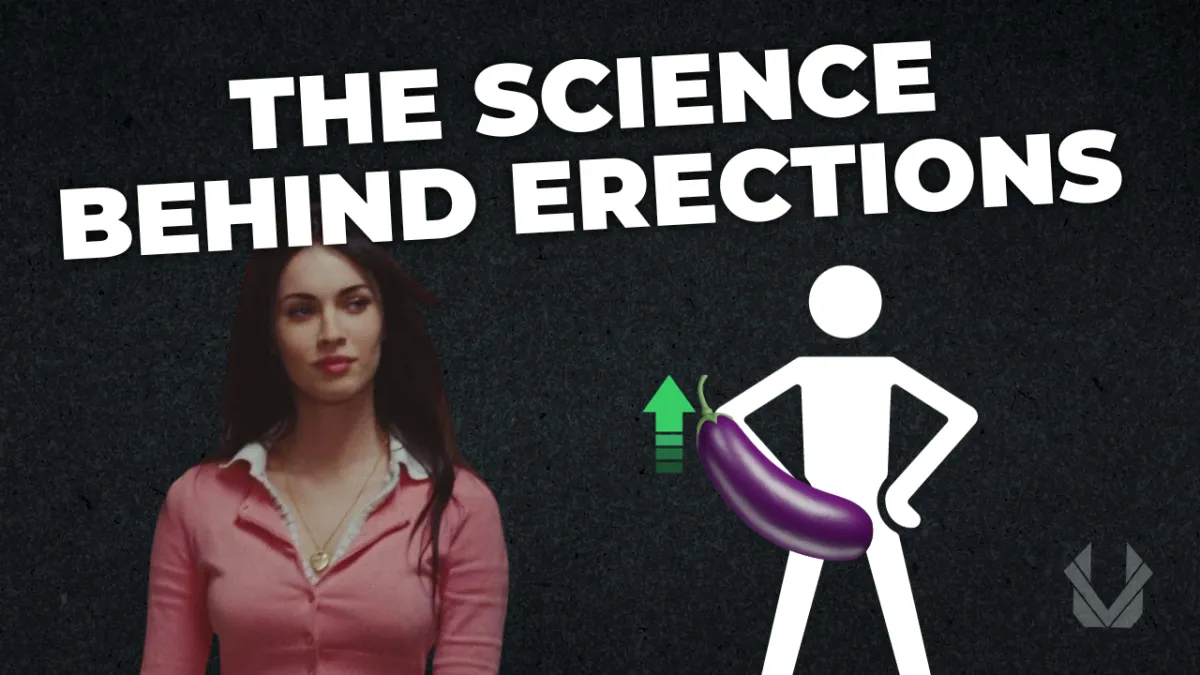THE UNYIELDING VIGOR BLOG
Our goal is to give you the most scientifically accurate and POWERFUL biological enhancement resources in the world
We're here to set new standards for truth, accuracy and effectiveness in the health industry. You'll find more value and scientific proof in our free articles than in most content you pay for.

The physiology behind erections:
INTRO
As someone deeply passionate about optimizing health and well-being, I've dedicated myself to understanding every aspect of male sexual function, knowing that strong erections are not just a sign of virility but also a reflection of overall health.
In this comprehensive post, we'll unravel the mysteries of nitric oxide synthesis and its pivotal role in driving blood flow to the penis—a fundamental factor in erection quality.
With my background as a health-obsessed engineer (with OCD) and exclusive access to cutting-edge scientific literature, I've delved deeper into understanding erections than most people ever could.
Why this obsession with erections, you may ask? Because I firmly believe that when our sexual health is optimized, it's a testament to our overall well-being. And through this knowledge, I aim to empower men to reclaim their sexual vitality and confidence.
By the end of this article, you'll not only have a deep understanding of the mechanics behind erections but also the tools to unlock your inner vigor and evolve every day.
Overview of Nitric Oxide Synthesis:
NO, synthesized by NO synthase (NOS), relies on three primary enzymes – neuronal (nNOS), endothelial (eNOS), and inducible (iNOS). When Ca2+ levels surge, calmodulin binds to these NOS enzymes (except iNOS), setting off a cascade involving l-arginine, NADPH, FAD, FMN, and BH4 as cofactors in NO synthesis ¹.
The pivotal role of nNOS in facilitating erections
nNOS is prevalent in brain regions like the hippocampus, cerebellum, and hypothalamus, with a focus on the Paraventricular Nucleus (PVN).
Activation of NO in the PVN:
In the PVN, NO acts intracellularly, activating oxytocinergic neurons projecting to the spinal cord, and then to the erectile tissues, mediating penile erection ² ³ Injection of NO donors, such as L-arginine, directly into the PVN facilitates erections in mice.
The activation of NO in the PVN is facilitated by neurotransmitters such as dopamine, oxytocin, NMDA, hexarelin peptides, and VGF peptides. These neurotransmitters and peptides increase Ca2+ levels, stimulating NOS and consequently enhancing NO production. This activation can be further supported by supplements that boost the mentioned neurotransmitters or in real-life scenarios such as visual, auditory, olfactory, tactile, and imagination. Other compounds like L arginine or citrulline malate can increase NO centrally as well ⁴.

Testosterone also plays an essential role in activating the PVN, possibly by influencing the oxytocinergic receptors in the PVN. The evidence is twofold: when oxytocin is administered centrally, it induces penile erections. In the case of castration or hypophysectomy, both of which result in lower testosterone levels, the ability of oxytocin to induce penile erection is abolished. However, when testosterone is supplemented back, the effect is again reversed ⁵.
Inhibition of NO in the PVN:
Conversely, GABA A agonists, opioids, and cannabinoids reduce NO production in the PVN, potentially negatively affecting erectile function ⁶.
VTA and Other neural Areas
The Ventral Tegmental Area (VTA) plays a crucial role, where NO synthase activation in dopaminergic neurons contributes to penile erection. Here, NO does not act intracellularly, but rather NO activates guanylate cyclase, increasing cGMP levels, ultimately leading to dopaminergic projections and dopamine release in the nucleus accumbens and medial prefrontal cortex, which will increase CA2+ in the PVN and induce penile erection ⁷ ⁸.
*NO also acts in the medial preoptic area, ventral subiculum, amygdala, and bed nucleus of the stria terminalis, although these roles are less understood.
Other forms of NOS involved in erections
eNOS and its positive role in erections
While nNOS has a central role in mediating erections through brain-spinal cord-erectile tissue pathways, eNOS contributes significantly to the vascular aspects of erectile function.
When it comes to eNOS, its activation is closely linked to the regulation of blood flow and vascular health. The endothelium, or the inner lining of blood vessels, releases nitric oxide in response to various stimuli.The synthesis of nitric oxide by eNOS involves a similar cascade of events as described for nNOS. Increased levels of intracellular calcium (Ca2+), facilitated by the binding of calmodulin, stimulate eNOS to convert l-arginine into nitric oxide. This nitric oxide then diffuses to smooth muscle cells in blood vessel walls, leading to relaxation and vasodilation, which is a key factor in achieving and maintaining an erection.
iNOS and its inhibitory role in erections
While eNOS and nNOS are CA2+/calmodulin dependent, iNOS is Ca2+ independent. This makes iNOS expression inducible, meaning it is activated in response to certain stimuli, such as inflammatory signals. It seems that iNOS activation can be counterproductive for facilitating erections, and diabetic mice with erectile dysfunction taking an iNOS inhibitor experienced improvements to erectile strength ⁹.
Testosterone's Influence on NO and Erections:
Testosterone increases NO by activating eNOS through the androgen receptor and the PI3-kinase/Akt pathway. AR antagonists effectively inhibit this process. Additionally, PDE5 expression is downregulated in the presence of normal and high T levels ¹⁰.
Testosterone deficiency triggers endothelial dysfunction by reducing NO levels through altered NO synthase activity and increased ADMA expression ¹¹.
In a study involving castrated rats, ENOS became uncoupled, inhibiting the ability for the rats to get an erection. ENOS began production of superoxide radical (O2-) and there was less BH4 to support eNOS, all of the above caused a lot of oxidative stress and worsened cardiovascular health ¹².
Oxidative Stress and NOS Functioning:
Superoxide production directly oxidizes the critical NOS cofactor BH4, leading to BH4 depletion and NOS uncoupling. Additionally, it can induce NADPH oxidase. When NO interacts with superoxide, peroxynitrite, a reactive nitrogen species, is formed. This peroxynitrite disrupts the NOS dimer, inducing NOS uncoupling. All of the aforementioned processes cause oxidative stress, which can worsen mitochondrial function and even damage the myocardium ¹³.
Oxidative stress can uncouple NOS, converting it into an enzyme that produces O2 rather than NO. Maintaining sufficient antioxidant status is crucial to prevent this uncoupling. The production and degradation of ADMA are also regulated by redox-sensitive enzymes PRMT and DDAH. Increased oxidative stress can upregulate PRMT and downregulate DDAH, leading to elevated ADMA concentrations. ADMA is a risk factor for all-cause mortality according to this meta analysis ¹⁴ and can also uncouple eNOS ¹⁵.
Additionally, s-glutathionylation of NOS is another mechanism that can cause uncoupling, decreasing NO production and increasing superoxide (O2) generation. S-glutathionylation occurs on conserved cysteine residues and can reduce endothelium-dependent vasodilation ¹⁶.
Preventing NOS uncoupling:

Blocking Upstream ROS Production:
-Ensuring normal-high testosterone levels as testosterone deficiency can increase ADMA ¹⁷, uncoupling eNOS and causing ROS.
Inhibiting NADPH
-Vit c inhibits NADPH oxidase, prevents iNOS expression(a good thing), scavenges superoxide and preserves BH4, ensuring there is enough cofactor for recoupling NOS ¹⁸. BH4 is also essential for tyrosine hydroxylase production, the rate limiting step in dopamine production ¹⁹.
-Exercise raises NAD/NADH ratio ²⁰, which improves NAMPT, the NAD+ regenerating enzyme, which has been shown to be more effective than NAD precursor supplementation strategies.
-blocking the AT1 receptor with telmisartan can prevent NADPH oxidase expression and increase eNOS ²¹.
-Vitamin D3 suppresses the NADPH oxidase subunit p22(phox) thus decreasing ROS and improves coupling of NOS, thus increasing NO, thus benefiting endothelial function ²² ²³.
Conclusion
Having adequate hormones like testosterone and dopamine plays crucial roles in facilitating proper nNOS and eNOS functions. Powerful lifestyle interventions such as exercise and antioxidants like vitamin C can help ensure that NOS reactions remain high and that NOS does not become uncoupled and cause oxidative stress.
Unleash Your Vigor and Conquer Your Limits,
-Brenden Henry
GET OUR NEW, FREE TESTOSTERONE SUPPLEMENT GUIDE FOR 2024
Toxic Testosterone: The Hidden Health Risks of the 6 Most Common Testosterone Supplements
(Created and proven with the results of 107 scientific studies)

Unleash Your Vigor & Conquer Your Limits!
-Unyielding Vigor

